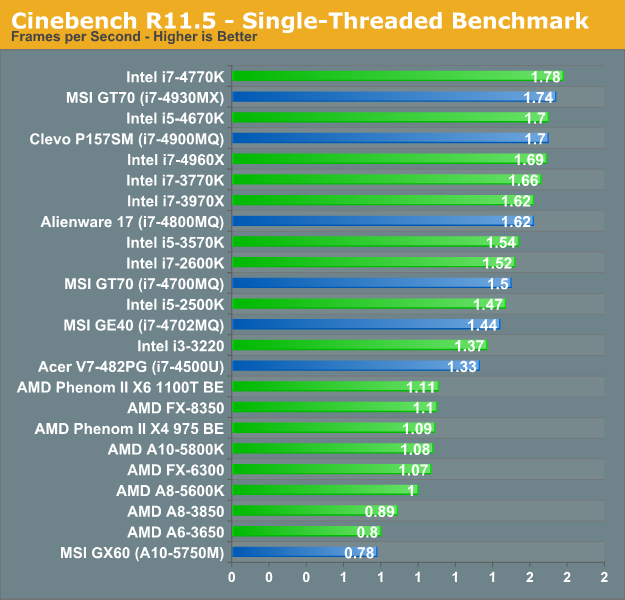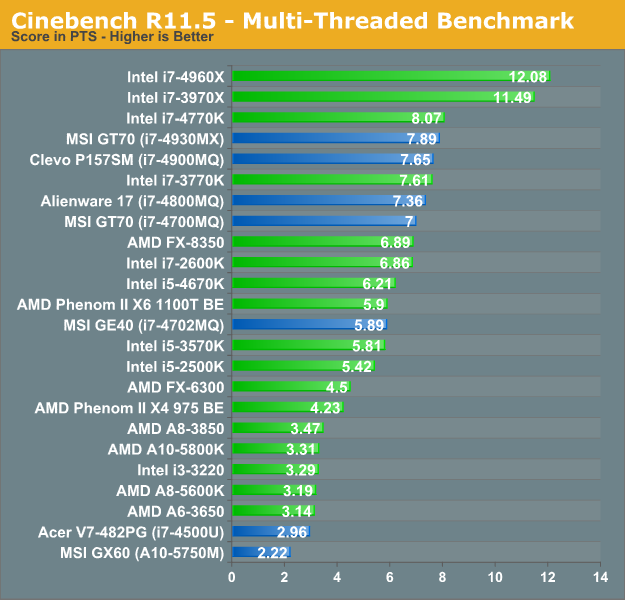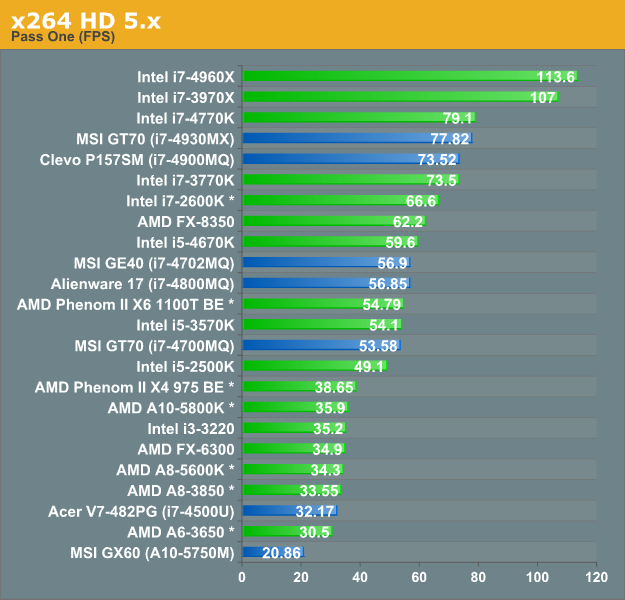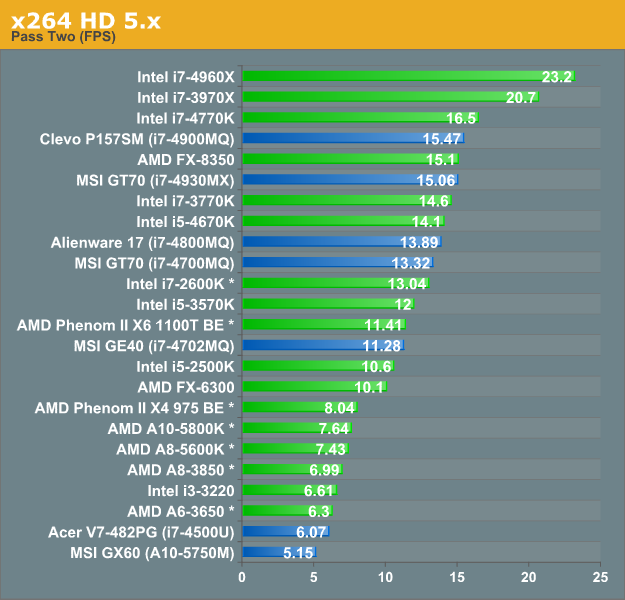Analyzing the Price of Mobility: Desktops vs. Laptops
by Jarred Walton on September 7, 2013 5:55 PM ESTCPU/General Performance Discussion
With that out of the way, let’s focus on the remaining two areas, starting with CPU performance. I’ve grabbed several generations of desktop CPUs from both AMD (K10.5, Llano, Trinity, Bulldozer, and Piledriver – we don’t currently have Richland results, but they’re generally 5-10% higher than Trinity) and Intel (Sandy Bridge, Sandy Bride-E, Ivy Bridge, Ivy Bridge-E, and Haswell) and combined those results with the latest mobile CPUs (Haswell quad-core, Haswell ULT, and Richland). We’ve got two benchmarks that are common to our CPU and laptop we’re going to look at: Cinebench 11.5 (single- and multi-threaded) and x264 HD 5.x video encoding (first and second pass).
Unfortunately, we don’t have results for all of the desktop CPUs in x264 HD 5.x, though you can get an idea of where they should fall by looking at the x264 HD 3.x results. We’ve gone ahead and used the x264 3.x scaling for desktop CPUs where we don’t have 5.x results, and marked those results with an asterisk (*) in the following graphs. The first pass tends to be about 2x as fast with x264 HD 3.x, unless you have four cores with Hyper-Threading in which case scaling is closer to 1.5x (and 6-cores results in scaling of around 1.08x). The scaling in the second pass is much more uniform, with 3.x being around 2.75x as fast as 5.x. Since we’re already comparing apples and oranges in a sense (desktop and laptops, with different motherboard, RAM, etc.) we’re really just interested in an estimate of performance. Do not take the following charts as 100% definitive, but rather as a baseline comparison.




It used to be that if you wanted top CPU performance, a desktop system was absolutely required. These days, for lightly-threaded workloads the gap has narrowed substantially: a moderate i7-4700MQ Intel Haswell processor will get you around 85% of the performance of the desktop i7-4770K, and the i7-4930MX will get you 98% of the single-threaded performance. Even the i7-4500U Ultrabook is able to deliver 75% of the 4770K performance. Move to heavily threaded workloads and the gap grows (particularly if we included the hex-core processors), but the 4700MQ and 4930MX are still 81-87%/91-98% of the 4770K performance – it’s the dual-core mobile CPUs that really take a hit, with the i7-4500U delivering roughly one third (37-41%) the performance of the 4770K. Of course, if you’re not doing CPU intensive tasks like video encoding, the single-threaded performance will be the more pertinent result.
The AMD side of the equation isn’t nearly so rosy, at least if you want performance anywhere near that of a top-end desktop. Llano, Trinity, and Richland have been far more focused on reducing power use and increasing integrated graphics performance than on boosting CPU performance. The result is that in single-threaded performance, the fastest mobile Richland APU is less than half the performance of the 4770K, and in the multi-threaded tests it’s 26-31% of the 4770K performance. Comparing mobile Richland to desktop AMD parts doesn’t really help much either: in the single-threaded Cinebench result, it basically matches the Llano A6-3650 and is 12% slower than the A8-3850, while it trails most of the other AMD CPUs/APUs by nearly 30%. Move to multi-threaded workloads and it’s only able to deliver 30-60% of the more powerful AMD desktop APUs (and 60-80% of the desktop Llano APUs). Richland is still “fast enough”, but it’s definitely a value proposition as opposed to a performance option – the iGPU of Richland may be faster than HD 4000/4400/4600, but dGPUs like the GT 730M are still roughly twice as fast and available for not much more money. But we’re skipping ahead….
Summarizing the general performance of our mobile platforms, we’re able to come pretty close to the performance of desktop systems, and while there’s still a price premium in effect it’s definitely getting smaller than in the past. The least expensive laptop/notebook I can find right now with a quad-core Haswell CPU is the HP Envy 15t-j000, which you can currently get for $700 after the $100 instant discount. That will get you 8GB RAM, 1TB HDD, and Windows 8, but not too much else. Adding a 1080p LCD ($50), GT 740M ($70), and a backlit keyboard ($30) brings the total to $850. That’s roughly the same performance as a Sandy Bridge i7-2600K, and slightly faster than the Haswell i5-4670K. You can get a pre-built desktop from Newegg for $700 (which adds in an HD 7750 GPU), while a DIY system with similar specs to the laptop (e.g. no dGPU) will set you back $672 (see table below) – not including a mouse, keyboard, display, or speakers.
| Mainstream Desktop PC | ||
| Component | Description | Price |
| CPU | Intel Core i5-4670 (Quad-core, 3.4-3.8GHz, 6MB L3, 22nm, 84W) | $200 |
| Motherboard | ASRock Z87 Pro3 LGA-1150 | $115 |
| Memory | 2x4GB DDR3-1600 CL9 1.5V RAM | $65 |
| Storage | Seagate 1TB 7200RPM HDD | $70 |
| Optical Drive | SATA DVDRW (Lite-On) | $18 |
| Case | Antec Three Hundred | $60 |
| Power Supply | Seasonic 350W 80 Plus Bronze | $44 |
| Operating System | Windows 8 64-bit (OEM) | $100 |
| Total | $672 | |
In other words, if all you want is a computer for moderate needs, it’s not hard to see why laptops are displacing desktops for many people. In this case we’re able to get the same level of performance for potentially less money (depending on whether or not you need to buy an LCD, keyboard, and mouse). Desktops are still going to be far more upgradeable, and you can take a “basic use” desktop like the one above and upgrade it with a high-end graphics card for $300 to get a potent gaming PC. Adding more memory, more storage, upgrading the motherboard and CPU, etc. are all things that you can do with a desktop, whereas with laptops typically only the RAM and storage can be upgraded/replaced and if anything else breaks you’ll have to send it in for repairs (or buy a new laptop).p
We can go down to lower price points of course – there are desktop PCs with moderate hardware starting at just over $300, and they’re still more upgradable than laptops, but similar performance laptops can be had for about the same price, especially if you look at some of the previous generation hardware. It’s mostly a question of how much performance you want/need, and whether you’re interested in the potential to upgrade components down the road. If you don’t have any plans of adding more RAM, storage, or a GPU the case for laptops is stronger now than ever. And let’s not forget that most laptops have an idle power draw south of 20W, compared to 40-60W for a typical desktop (and that’s not including the display or speakers on the desktop), so the energy factor also favors laptops.










110 Comments
View All Comments
BlakKW - Sunday, September 8, 2013 - link
Thanks for the article...it was interesting, and results were not entirely what I expected them to be.Selbatrim - Sunday, September 8, 2013 - link
This has partially been picked up but I think this article is a bit of old rubbish myself. The laptop in question firstly uses a 5400rpm HDD and does not include an optical drive. Additionally the desktop system is a custom build with plenty of room to shave off cost. Case and PSU easily reduced by $50, motherboard too. I'd say (including dropping the GPU) you would reduce the price of the desktop by about $400 and still have a higher performing device.And this is still a custom build, not an OEM build.
I've just priced up a laptop vs desktop replacement for our fleet and the desktop (including peripherals) come in at about 60%-75% of the cost of a laptop (depending on portability). Add to that you mostly need to factor in a port replicator for the laptop the desktop wins hands down.
Can you get a reasonably priced laptop these days that will do general computing for less then $1000? Sure. Can the same money buy you a much better desktop? You betcha.
wintermute000 - Sunday, September 8, 2013 - link
Yeah around 1/3rd cheaper sounds around right (+ expandability, repair, upgrade path etc.)JarredWalton - Monday, September 9, 2013 - link
I looked at pre-built OEM PCs and none of them really came in much cheaper than the custom build without serious compromises on some areas. Getting a cheap $25 case and $25 PSU is also a bad idea, so I specifically went against that and included a decent case and a good quality 80 Plus Bronze PSU -- even the OEMs are avoiding crap PSUs these days.Except... crap, my tables on the desktop are screwed up. There are supposed to be two different builds, one for gaming, one for "standard" use (no GPU). Let me fix that, because the mainstream desktop isn't all that different but costs $200 or so less.
JarredWalton - Monday, September 9, 2013 - link
Okay, fixed the table. Sorry about that -- funny that you're the first to notice. I had the text right (it mentioned the $672 price), but somehow copied the same table into the document from my spreadsheet.Selbatrim - Monday, September 9, 2013 - link
I'd not recommend a rubbish psu either but Seasonic is a high end brand. As is the Z87 chipset. If quality and durability is part of your desktop build then you should chose the same in your laptop. A HP Envy is not a high quality laptop. It is pretty much a mid-lower end in terms of build quality.The issue of the HDD speed comparing a desktop 7200 rpm to a laptop 5400 rpm will also have a major impact on performance (or drop the price on the desktop). But even still, your results point to a laptop of SIMILAR specs being comparable if not competitive with a desktop and this is simply not true.
Asrock H81M-HDS motherboard for $52 (save $63)
COUGAR Solution Black Steel ATX Mid Tower (INC 400W 80+ PSU) $80 (save $24)
No Optical drive (Envy does not have this. Save $18)
Total now of $567 and you still have a better CPU and HDD.
Again, yes, you get better laptops now than you used to and you can easily replace your desktop with a laptop but it will cost more (and you still need extra monitor, keys etc to use it full time or suffer the consequences)
ChuckEX - Sunday, September 8, 2013 - link
I will always browse through and appreciate articles on computer performance, but for me, they will only serve as guides. It amazes me how people fail to take into account "real world performance". Of course, on the bench, the numbers say anything other than the most bleeding edge hardware and you are missing out.I'm rock'in an extremely humble laptop with an AMD A6 4400m chip. I paid $300 open box for it, removed all the bloatware, maxed out the RAM (from 4GB to 8GB) and got a quality Thermaltake cooling pad. I've played through Skyrim, Tomb Raider (2013), Dishonoured, Bioshock Infinity and tons of other "demanding" games. I'm currently playing Splinter Cell: Blacklist no problem. Granted, my graphics settings are low/medium, however, these games still look and play great.
I guess it's just down to personal preference. If you're gonna chase the numbers, you'll never be satisfied. If you tone it down and have realistic expectations, you can have just as much fun as everyone else. I think computer graphics have reached a plateau. Everyone goes on about how beautiful a game looks on the PS3/XBox 360 to this day - 7 year old technology! And tablet games are looking better and better.
Don't get me wrong. I've had many PC builds and I aspire to get the most bang for my buck. I'm just blown away at what I'm able to do with this humble little laptop.
JarredWalton - Monday, September 9, 2013 - link
I get what you're saying, and certainly turning down details can help, but some of the games you mention I have trouble believing they run well at all on an A6-4400M iGPU (HD 7520G). That's half the performance of the 7660G, which struggles with several of the games on our list (Tomb Raider at Low detail is 48FPS average, so I suppose it might get >30FPS at 1024x768 at Low, Bioshock is a similar story, and even Skyrim is going to be borderline at best -- Notebookcheck shows <30 FPS for Skyrim for instance (http://www.notebookcheck.net/AMD-Radeon-HD-7520G.7...The thing is, while I have no trouble saying "Medium 1366x768" is usually fine for quality -- it's the gameplay, right? -- there are many cases where "Low 1366x768" does not even compare. GRID 2, StarCraft II, Skyrim, and others look really bad at "Low" as opposed to "Medium". You might be okay with those setting, and they're going to be necessary on an A6-4400M, but I would not be happy with the overall experience.
KalTorak - Monday, September 9, 2013 - link
"Part of the problem is power requirements, as high-end desktop GPUs can draw up to 300W under load, which is three times what the most powerful mobile GPUs are rated to draw. The form factor also comes into play, but really I think power is the far more limiting factor."I don't see the distinction you're drawing in that last sentence; isn't it the form factor that determines the power constraints?
JarredWalton - Monday, September 9, 2013 - link
Perhaps somewhat, but a desktop GPU can suck down 300W (sometimes more for the dual-GPU on a PCB models), and the largest power brick I know of for laptops is rated at 300W. So form factor is part of the issue, yes -- you can only cool so much heat in a notebook -- but without 450W power bricks for notebooks you're never going to touch the performance of a desktop that draws 450W.